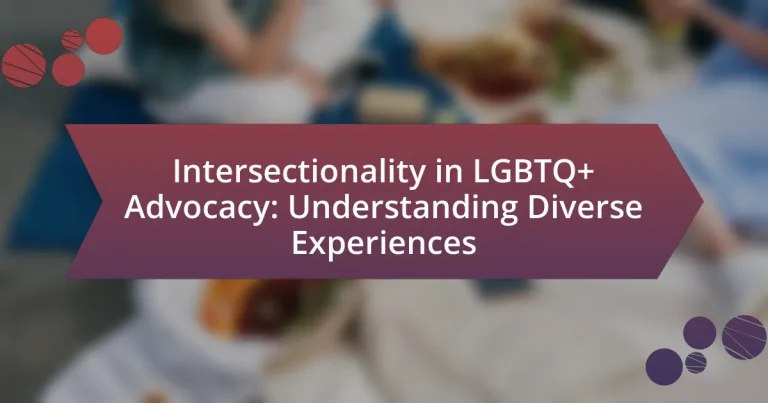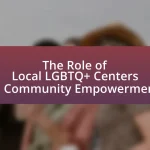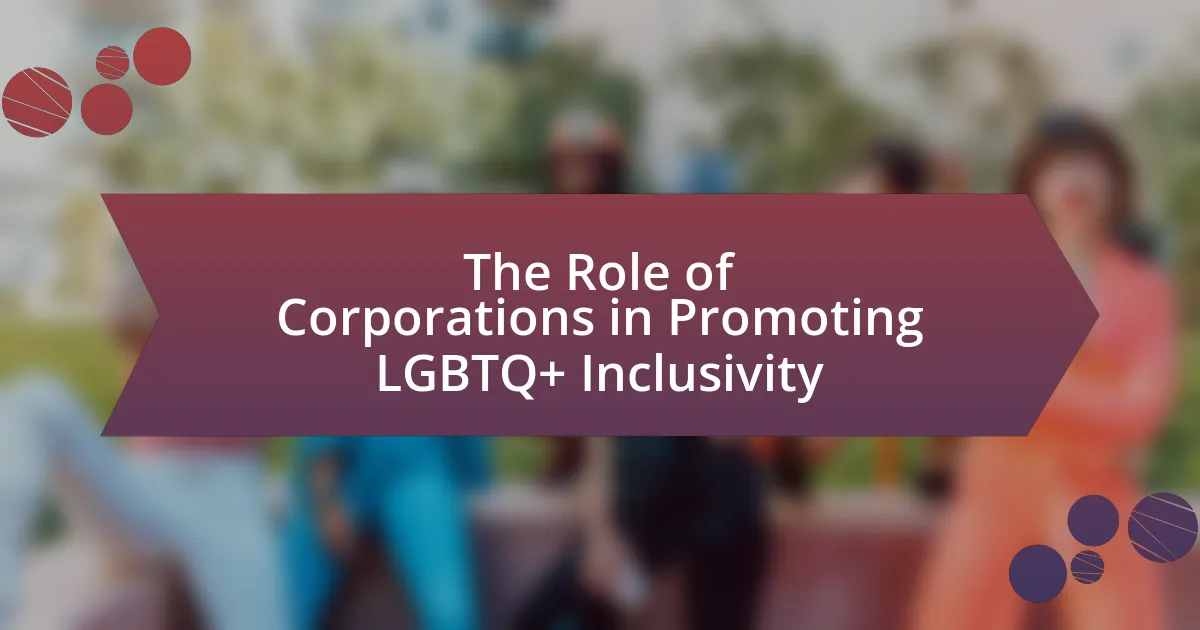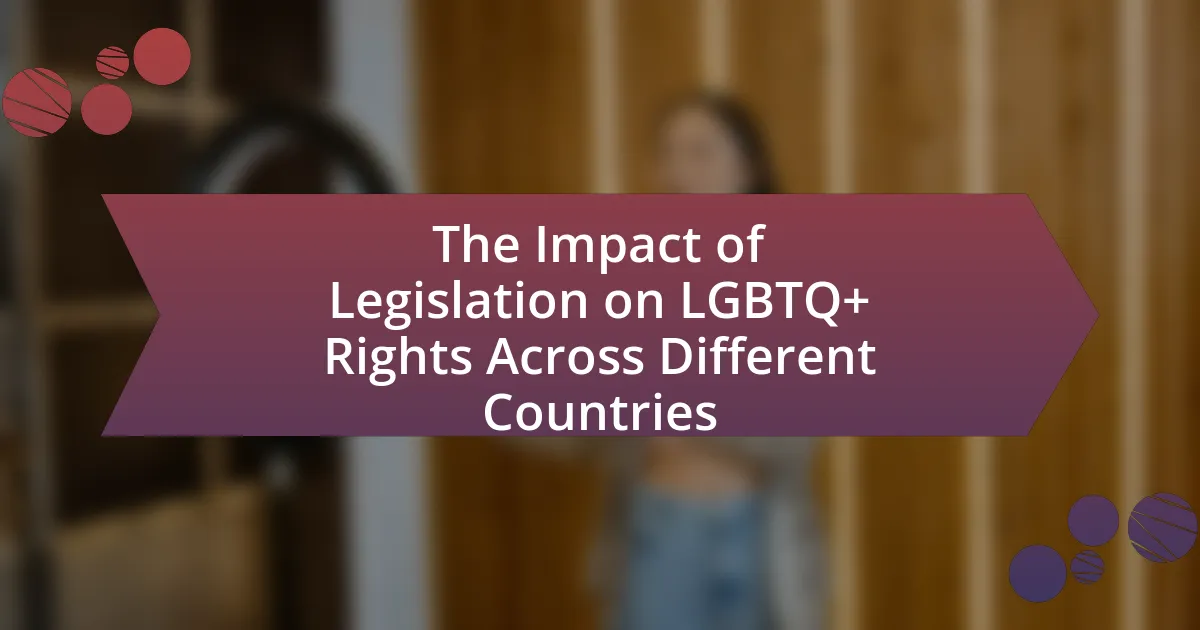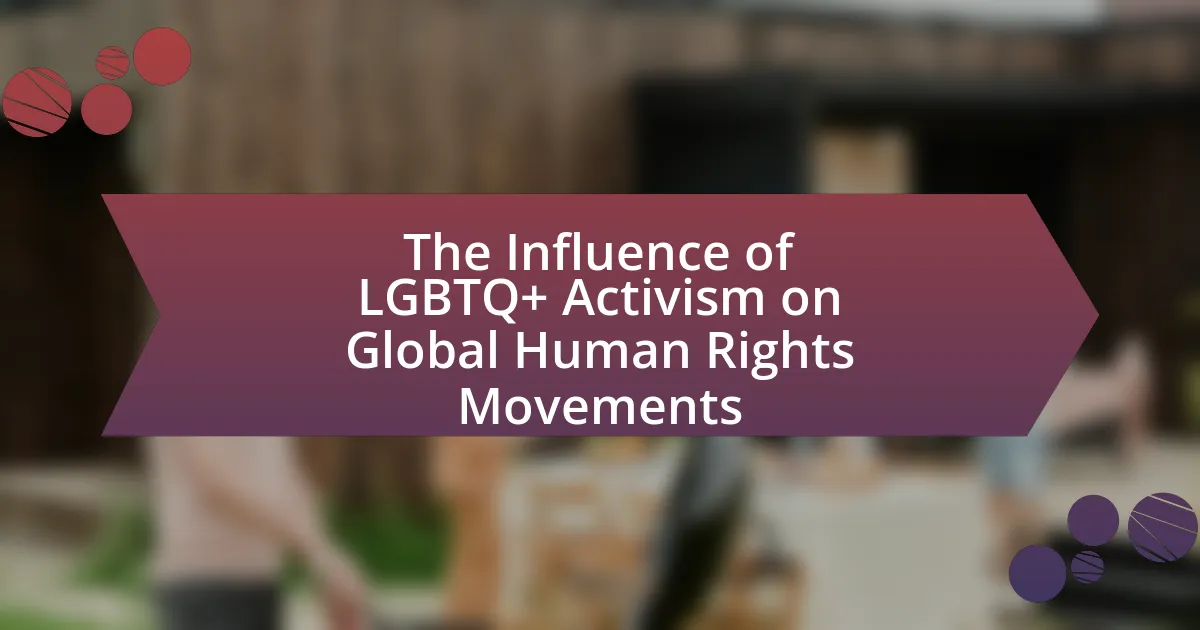Intersectionality in LGBTQ+ advocacy is a framework that acknowledges how overlapping social identities—such as race, gender, sexual orientation, and class—interact to shape unique experiences of discrimination and privilege within the community. The article explores how these intersecting identities influence the challenges faced by LGBTQ+ individuals, particularly those who are also people of color or from lower socioeconomic backgrounds. It emphasizes the importance of understanding intersectionality for effective advocacy, highlighting the need for inclusive policies that address the specific needs of marginalized groups. Additionally, the article discusses the potential pitfalls of overlooking intersectionality in advocacy efforts and provides strategies for ensuring diverse representation and ongoing engagement with various communities.

What is Intersectionality in LGBTQ+ Advocacy?
Intersectionality in LGBTQ+ advocacy refers to the framework that recognizes how various social identities, such as race, gender, sexual orientation, and class, intersect to create unique experiences of discrimination and privilege. This concept emphasizes that individuals within the LGBTQ+ community do not experience oppression uniformly; for instance, a Black transgender woman may face different challenges than a white gay man due to the overlapping effects of racism, sexism, and homophobia. Research by Kimberlé Crenshaw, who coined the term “intersectionality,” highlights the importance of considering these intersecting identities to address systemic inequalities effectively.
How does intersectionality influence the experiences of LGBTQ+ individuals?
Intersectionality significantly influences the experiences of LGBTQ+ individuals by highlighting how overlapping social identities, such as race, gender, and socioeconomic status, create unique challenges and forms of discrimination. For instance, LGBTQ+ people of color often face compounded biases that differ from those experienced by white LGBTQ+ individuals, leading to increased vulnerability to violence and discrimination. Research from the Human Rights Campaign indicates that LGBTQ+ individuals who also identify as people of color report higher rates of discrimination in various settings, including employment and healthcare, compared to their white counterparts. This intersectional lens is crucial for understanding the diverse experiences within the LGBTQ+ community and advocating for more inclusive policies that address these multifaceted issues.
What are the key components of intersectionality in this context?
The key components of intersectionality in the context of LGBTQ+ advocacy include the recognition of overlapping social identities, such as race, gender, sexual orientation, and socioeconomic status, which collectively shape individual experiences of discrimination and privilege. This framework emphasizes that individuals do not experience oppression or privilege in isolation; rather, their multiple identities interact to create unique challenges and perspectives. For instance, a Black transgender woman may face different forms of discrimination compared to a white cisgender gay man, highlighting the necessity of addressing these intersecting identities in advocacy efforts to ensure inclusivity and effectiveness.
How do different identities intersect within the LGBTQ+ community?
Different identities intersect within the LGBTQ+ community through the concept of intersectionality, which recognizes that individuals experience multiple, overlapping social identities that shape their unique experiences of discrimination and privilege. For example, a Black transgender woman may face distinct challenges that differ from those encountered by a white gay man, as her experiences are influenced by both her race and gender identity. Research by Crenshaw (1989) highlights how these intersecting identities can lead to compounded forms of marginalization, demonstrating that advocacy efforts must address the specific needs of diverse groups within the LGBTQ+ community to be effective.
Why is understanding intersectionality important for advocacy?
Understanding intersectionality is crucial for advocacy because it allows advocates to recognize and address the complex ways in which various social identities—such as race, gender, sexual orientation, and class—interact to create unique experiences of discrimination and privilege. This understanding enables advocates to develop more inclusive strategies that effectively address the specific needs of marginalized groups within the LGBTQ+ community. For instance, research by Crenshaw (1989) highlights how Black women face distinct challenges that are not fully addressed by either feminist or anti-racist movements alone. By incorporating intersectionality into advocacy efforts, organizations can ensure that their initiatives are equitable and responsive to the diverse experiences of all individuals, ultimately leading to more effective social change.
How does intersectionality affect the effectiveness of advocacy efforts?
Intersectionality significantly enhances the effectiveness of advocacy efforts by recognizing and addressing the diverse and overlapping identities individuals hold, such as race, gender, sexual orientation, and socioeconomic status. This approach allows advocates to tailor their strategies to meet the unique needs of marginalized groups, leading to more inclusive and impactful outcomes. For instance, research by Crenshaw (1989) highlights how Black women face discrimination that is not solely based on race or gender but rather the intersection of both, necessitating advocacy that considers these complexities. By incorporating intersectionality, advocacy efforts can better mobilize support, create targeted policies, and foster solidarity among various groups, ultimately leading to more comprehensive social change.
What challenges arise when intersectionality is overlooked in advocacy?
Overlooking intersectionality in advocacy leads to significant challenges, including the marginalization of specific groups within broader movements. When advocacy fails to consider the interconnected nature of social categorizations such as race, gender, and sexual orientation, it often results in policies and initiatives that do not address the unique needs of individuals who embody multiple marginalized identities. For instance, research by Crenshaw highlights that Black women face discrimination that is not adequately addressed by feminist or anti-racist movements alone, demonstrating that a singular focus can perpetuate inequalities. Additionally, the lack of intersectional awareness can alienate potential allies and diminish the effectiveness of advocacy efforts, as seen in various LGBTQ+ initiatives that do not fully represent the experiences of LGBTQ+ people of color. This oversight can lead to a failure in achieving comprehensive social justice, as the voices and needs of the most vulnerable are ignored.

What diverse experiences exist within the LGBTQ+ community?
The LGBTQ+ community encompasses a wide range of diverse experiences shaped by factors such as race, gender identity, socioeconomic status, and cultural background. For instance, Black LGBTQ+ individuals often face unique challenges related to both racial and sexual identity, leading to experiences of discrimination that differ from those of white LGBTQ+ individuals. Additionally, transgender individuals encounter specific barriers, including healthcare access and legal recognition, which can vary significantly based on their geographic location. Research indicates that LGBTQ+ youth of color are at a higher risk for mental health issues due to compounded societal pressures (Source: “The Intersection of Race and Sexual Orientation,” Williams Institute, 2020). Furthermore, the experiences of LGBTQ+ individuals can differ greatly in various cultural contexts, with some cultures being more accepting than others, impacting their sense of belonging and safety. These factors illustrate the complexity and richness of experiences within the LGBTQ+ community, highlighting the importance of intersectionality in advocacy efforts.
How do race and ethnicity impact LGBTQ+ experiences?
Race and ethnicity significantly impact LGBTQ+ experiences by influencing social acceptance, access to resources, and the intersection of discrimination. For instance, LGBTQ+ individuals from marginalized racial and ethnic backgrounds often face compounded discrimination, which can lead to higher rates of mental health issues and violence. According to the 2021 National LGBTQ+ Youth Report by The Trevor Project, LGBTQ+ youth of color reported higher rates of bullying and discrimination compared to their white counterparts, highlighting the unique challenges they face. Additionally, cultural norms within specific racial and ethnic communities can affect the acceptance of LGBTQ+ identities, further complicating their experiences. This intersectionality illustrates that race and ethnicity are critical factors in understanding the diverse experiences within the LGBTQ+ community.
What unique challenges do LGBTQ+ individuals of color face?
LGBTQ+ individuals of color face unique challenges that stem from the intersection of racial and sexual or gender identity discrimination. These individuals often experience compounded marginalization, which can manifest in various forms such as systemic racism, homophobia, and transphobia. For instance, a report by the Human Rights Campaign highlights that LGBTQ+ people of color are more likely to face violence and discrimination compared to their white counterparts, with 47% of Black LGBTQ+ individuals reporting discrimination in employment settings. Additionally, they may encounter barriers in accessing healthcare, as studies indicate that LGBTQ+ individuals of color often face higher rates of mental health issues and are less likely to receive adequate support due to cultural stigma and lack of culturally competent care. This intersectional discrimination creates a complex landscape of challenges that requires targeted advocacy and support.
How can advocacy address the needs of LGBTQ+ people of different racial backgrounds?
Advocacy can address the needs of LGBTQ+ people of different racial backgrounds by promoting inclusive policies that recognize and respond to the unique challenges faced by these individuals. For example, intersectional advocacy efforts can focus on combating both racial discrimination and homophobia, ensuring that services are culturally competent and accessible. Research indicates that LGBTQ+ people of color often experience higher rates of violence and discrimination; thus, advocacy must prioritize safety and support systems tailored to their specific experiences. Organizations like the Human Rights Campaign and the National Black Justice Coalition actively work to amplify the voices of LGBTQ+ people of color, providing resources and representation that reflect their diverse identities.
What role does socioeconomic status play in LGBTQ+ advocacy?
Socioeconomic status significantly influences LGBTQ+ advocacy by affecting access to resources, representation, and the ability to mobilize for rights. Individuals from higher socioeconomic backgrounds often have greater access to education, healthcare, and legal support, which enhances their capacity to advocate effectively. Conversely, those from lower socioeconomic backgrounds may face barriers such as financial instability, discrimination, and lack of access to supportive networks, which can hinder their advocacy efforts. Research indicates that socioeconomic disparities within the LGBTQ+ community can lead to unequal representation in advocacy spaces, as seen in studies highlighting that LGBTQ+ individuals with lower incomes are less likely to participate in activism compared to their wealthier counterparts. This disparity underscores the importance of addressing socioeconomic factors to create a more inclusive and effective advocacy landscape.
How does economic inequality affect access to resources for LGBTQ+ individuals?
Economic inequality significantly restricts access to resources for LGBTQ+ individuals by limiting their financial means to secure essential services such as healthcare, housing, and legal support. For instance, LGBTQ+ individuals often face discrimination in employment, leading to higher rates of unemployment and lower wages compared to their heterosexual counterparts. According to a 2021 report by the Williams Institute, LGBTQ+ individuals are more likely to experience poverty, with 22% living below the federal poverty line, compared to 16% of non-LGBTQ+ individuals. This economic disadvantage directly impacts their ability to access critical resources, exacerbating health disparities and limiting opportunities for social mobility.
What strategies can be implemented to support economically disadvantaged LGBTQ+ communities?
To support economically disadvantaged LGBTQ+ communities, targeted financial assistance programs should be implemented, including grants and scholarships specifically designed for LGBTQ+ individuals. Research indicates that LGBTQ+ individuals face higher rates of poverty and unemployment compared to their heterosexual counterparts, with a 2020 report from the Williams Institute showing that 29% of LGBTQ+ adults live in poverty. Additionally, creating job training and employment programs that focus on inclusivity can help improve economic opportunities. For instance, initiatives like the LGBTQ+ Employment Network provide resources and support for job seekers within these communities. Furthermore, access to affordable healthcare and mental health services is crucial, as economic instability often exacerbates health disparities. Programs that offer legal assistance for discrimination cases can also empower individuals to advocate for their rights in the workplace.
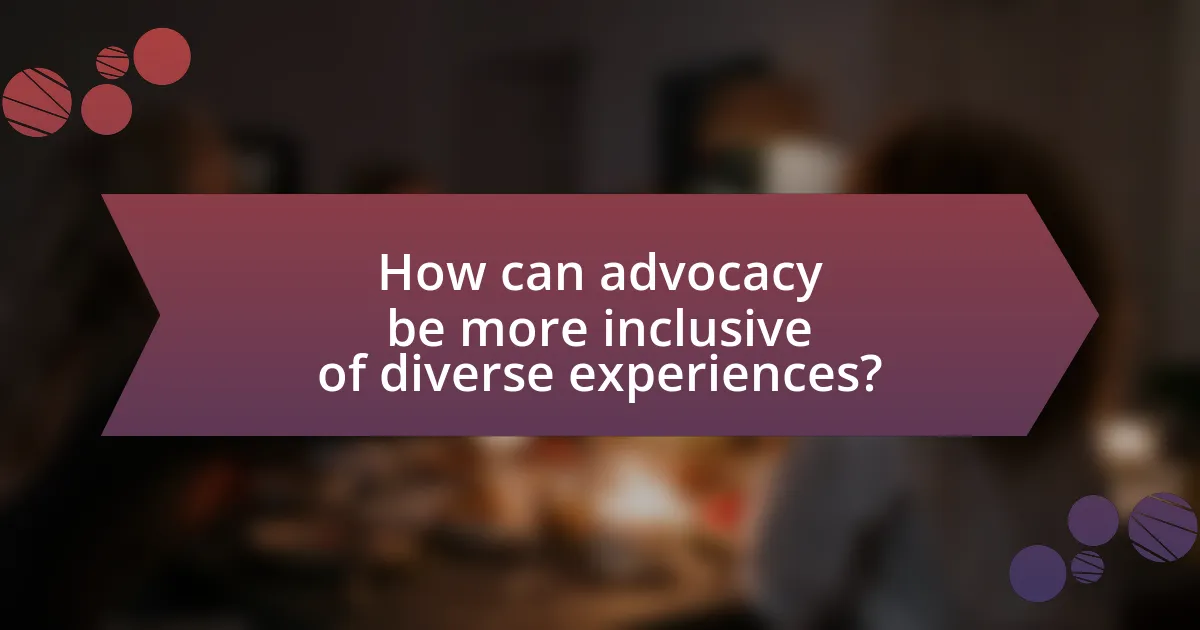
How can advocacy be more inclusive of diverse experiences?
Advocacy can be more inclusive of diverse experiences by actively incorporating intersectional approaches that recognize and address the unique challenges faced by individuals at the intersections of multiple identities. This can be achieved through the representation of diverse voices in decision-making processes, ensuring that advocacy campaigns reflect the varied experiences of marginalized groups within the LGBTQ+ community. Research indicates that intersectional advocacy leads to more effective outcomes, as it acknowledges the complexity of identities and the systemic barriers that individuals face (Crenshaw, 1989). By prioritizing inclusivity, advocacy efforts can better serve the needs of all individuals, fostering a more equitable environment.
What best practices can enhance intersectional advocacy?
Best practices that can enhance intersectional advocacy include actively listening to and amplifying the voices of marginalized groups within the LGBTQ+ community. This approach ensures that advocacy efforts reflect the diverse experiences and needs of individuals, particularly those who face multiple layers of discrimination, such as people of color, transgender individuals, and those with disabilities. Research indicates that inclusive advocacy strategies lead to more effective policy changes and community support, as seen in initiatives like the Human Rights Campaign’s work on intersectional issues, which has resulted in increased visibility and resources for underrepresented groups. By prioritizing collaboration with grassroots organizations and fostering an environment of shared leadership, intersectional advocacy can create a more equitable and just framework for all members of the LGBTQ+ community.
How can organizations ensure they are representing diverse voices?
Organizations can ensure they are representing diverse voices by actively engaging with a wide range of community members and stakeholders. This involves implementing inclusive recruitment practices that prioritize diversity in hiring, ensuring representation from various backgrounds, including race, gender identity, sexual orientation, and socioeconomic status. Research indicates that organizations with diverse teams are 35% more likely to outperform their peers (McKinsey & Company, 2020). Additionally, organizations should create platforms for marginalized voices to be heard, such as focus groups, surveys, and community forums, which facilitate open dialogue and feedback. By integrating these practices, organizations can better reflect the diversity of the communities they serve and enhance their advocacy efforts.
What training or resources are necessary for advocates to understand intersectionality?
Advocates need comprehensive training on intersectionality that includes workshops, seminars, and educational materials focused on the interconnectedness of social identities. Resources such as academic literature, case studies, and online courses specifically addressing intersectionality in the context of LGBTQ+ issues are essential. For instance, the “Intersectionality 101” workshop by the Center for Intersectional Justice provides foundational knowledge and practical applications. Additionally, the book “Intersectionality” by Kimberlé Crenshaw offers critical insights into the theory and its implications for advocacy. These resources equip advocates with the necessary tools to understand and address the complexities of diverse experiences within the LGBTQ+ community.
What are the common pitfalls in intersectional advocacy?
Common pitfalls in intersectional advocacy include oversimplification of identities, lack of representation, and failure to address power dynamics. Oversimplification occurs when advocates reduce complex identities to single categories, neglecting the multifaceted nature of individuals’ experiences. Lack of representation can lead to the exclusion of marginalized voices, which diminishes the effectiveness of advocacy efforts. Additionally, failing to address power dynamics can result in reinforcing existing inequalities rather than dismantling them. These pitfalls hinder the ability to create inclusive and effective advocacy strategies that truly reflect the diverse experiences within the LGBTQ+ community.
How can advocates avoid tokenism in their efforts?
Advocates can avoid tokenism by actively engaging with and amplifying the voices of marginalized communities within the LGBTQ+ spectrum. This involves prioritizing genuine representation and inclusion in decision-making processes, ensuring that diverse perspectives are not only heard but also valued. Research indicates that organizations that implement inclusive practices, such as forming advisory boards composed of individuals from various backgrounds, experience greater effectiveness in advocacy efforts. For instance, a study by the Human Rights Campaign found that inclusive advocacy leads to more comprehensive policy outcomes that reflect the needs of all community members.
What steps can be taken to ensure ongoing engagement with diverse communities?
To ensure ongoing engagement with diverse communities, organizations should implement inclusive outreach strategies that prioritize active listening and collaboration. Engaging with community leaders and representatives fosters trust and ensures that the voices of diverse groups are heard and valued. For instance, hosting regular community forums allows for open dialogue, enabling organizations to understand specific needs and concerns. Additionally, utilizing social media platforms to reach a broader audience can enhance visibility and participation. Research indicates that organizations that actively involve community members in decision-making processes see increased engagement and satisfaction, as evidenced by a study published in the Journal of Community Psychology, which found that participatory approaches lead to more effective community programs.
What practical steps can advocates take to support intersectionality in their work?
Advocates can support intersectionality in their work by actively incorporating diverse perspectives and experiences into their advocacy strategies. This can be achieved by conducting inclusive research that highlights the unique challenges faced by individuals at the intersections of multiple identities, such as race, gender, and sexual orientation. For instance, studies like “Intersectionality and LGBTQ+ Advocacy” by Crenshaw emphasize the importance of recognizing how overlapping identities affect individuals’ experiences and access to resources. Additionally, advocates should engage in community outreach to ensure that marginalized voices are represented in decision-making processes, thereby fostering an environment where all individuals feel valued and heard.
